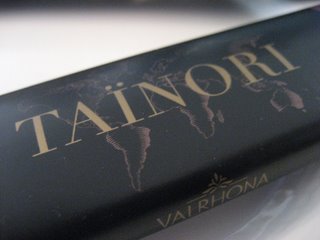At least I was clear on the day's theme.
While waiting for the seminar to begin, I chatted with some people I knew and then sat down to talk to my neighbor, who I didn't know-- an amateur chocolatier from Marin. When she mentioned how excited she was about her purchase of a new chocolate tempering machine, I knew I was in alien territory. "You mean they have machines to do that?" I asked, sadly in all seriousness. It was clear that what I knew about chocolate could fill a diaper. I've formulated opinions about chocolate in my life, to be certain-- which types and brands I prefer and why, but I've never given the art of making chocolate much thought. I knew, of course, that chocolate is derived from a pod that thrives in equatorial climates, but the rest was a complete blank.
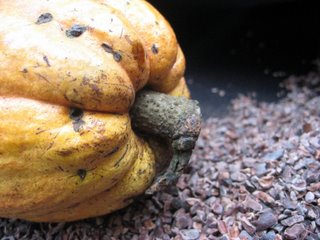
Fortunately, that was about to change...
When the tent was filled and everyone had finally taken their seats, the audience was introduced to Pierre Costet, Valrhona's chief cacao sourcer and Vanessa Lemoine, their sensorial analysis expert. With the aid of headphones and simultaneous translators of both sexes, we were kept informed-- and entertained-- for nearly three hours.
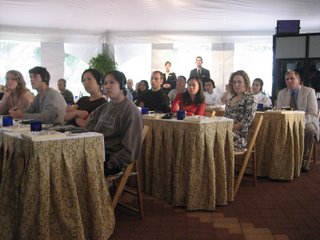
There is entirely too much to recount for the purposes of this blog, so I will give you what I think were the highlights...
In a short, dramatic re-creation, Costet, wearing his field cap and wielding a knife, took us through the process of sourcing cacao beans, after which he handed a prop burlap sack to Lemoine for analysis. Not exactly Comédie Française material, but I enjoyed the effort.
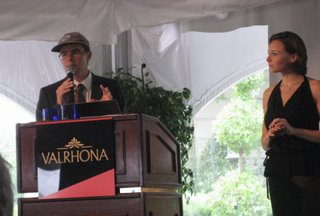
After explaining the process of cacao analysis, which included extras holding up their assessments to the audience, Lemoine then handed the sack back to Costet who explained that, if the cacao was found suitable by Valrhona for making chocolate, it must then be determined if the source of the beans is stable. Stable? Equatorial countries are not typically known as stable sources of trade, whether the reasons be political instability (Ivory Coast), political hostility (Venezuela), or a proneness to uninviting weather phenomena (Malaysia). If the source is determined to be stable, Valrhona then proceeds to hammer out a deal with the new grower, opting to set prices directly rather than deal with middlemen and the fluctuations of a volatile cacao exchange. According to Valrhona, this leads to more money for the growers and, hopefully, higher wages for the laborers. In Venezuela, for example, plantation owners must pay wages competitive with those offered by the government-- they actually have to entice labor.
Our political correctness satisfied, we could now move on to what we all really came for, tasting chocolate...
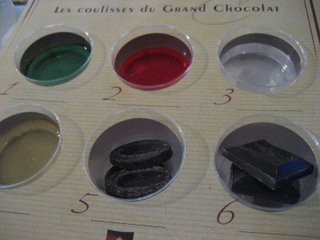
We proceeded to examine les coulisses du Grand Chocolat. A coulisse is (not surprising given the nature of the day's lecture) a theatrical term. It refers to either the wings of a stage or the place where backgrounds are stored. Lemoine was determined to set the stage, to have in place the proper background, before we began to actually taste chocolate.
We were instructed to hold a series of liquids under our nose to examine its odor, which is taken directly into the nasal passage. Did I smell apple? Melon? Dog biscuit? Next, we sipped each the liquid, holding it in our mouths, which helped us detect its aroma, which we learned is information taken indirectly or post nasally. Apparently, 90% of what we think of as taste is actually aroma-- information received through the nose, not the tongue. It is little wonder then, I thought, that the French are so tasteful. Then I thought again. Aromatic would be the correct term.
True taste is detected by the tongue. Conventional Western wisdom long kept a short list of four true taste sensations (sweet, salty, bitter, acid) and only recently allowed a fifth umami) onto the team. According to Lemoine, there are more than 1,000. We tried a sixth distinct taste (licorice). I was disappointed we didn't get to discuss this point further, but I think that might have been a bit overwhelming.
How To Taste Chocolate:
1. Look at it. Is it dark or milky? Is there a sheen or a matte finish?
2. Hold the chocolate to your nose and take in its odor.
3. Break a piece between your fingers. Is there a sharp snap or is there some give? A good snap is a sign of good tempering.
4. Put a piece of the chocolate into your mouth and assess its texture.
5. Allow the chocolate to melt in your mouth. Press it against your palate with your tongue. More of the aroma will now be released. Unless there is something very wrong with you, you will begin to salivate due to the chocolate's acidity. As you wait for the tang to subside, pay special attention to the back of your tongue. Is bitterness detected? Please limit your thoughts to the chocolate, not your life. Or your neighbor.
6. Repeat as often as necessary.
This approach to tasting chocolate struck me as very similar to the way one approaches the tasting of wine. The information is processed in very much the same way and in the same order. Just as there are those among us who can pick out a Griotte- Chambertin in a blind wine tasting, there are people, like Lemoine, who could spot the Araguani in a crowd. Both, in their own spheres, are given the title Grand Cru. The Griotte-Chambertin is a true Grand Cru, with its own A.O.C. designation. Valrhona's "Grand Cru" is more of a pretention, but one that tells the public that this is serious chocolate-- chocolate identified by terroir (another allusion to wine), cacao varietal, and blending.
I must admit that a chocolate glaze poured over my brain at about the second hour. To read about the different chocolates we tasted, I am sending you over to Dorie Greenspan, who took better notes on the subject than I did. She went to the seminar in New York the day prior.
All the chocolate we tasted was excellent, naturally, but the item I was most excited to try was basically chocolate detritus-- the cacao pulp. When fresh, as we tried it, the texture and flavor reminded me of a slightly underripe mango. The bean, unfermented and unroasted, was bitter and unpleasant. I wondered how anyone ever got the idea to turn this bitter little seed into something so utterly sensual and desirable as chocolate.
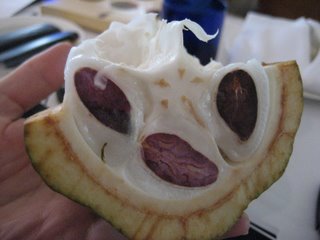
After the three hours of lecture and tasting, I was ready to stand up and stretch my legs. There were more Valrhona-related treats to be had, prepared by Yann Duytsche (who was plugging his book, Diversiones Dulces at the event)...
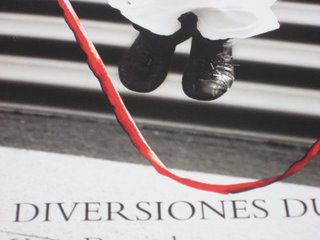
...and Valrhona USA's Derek Poirier. A tasting of five rather playful desserts, including a cocoa nibs foam with candied asparagus, Tainori jelly with tomato and basil, and an Abinao hot chocolate with Cramique brioche and aubergine jam (my hands down favorite)...
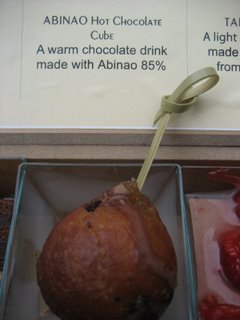
The confections were playful, to say the least. I was surprised at how well items like tomato and eggplant lent themselves to sweet dishes, but it all made sense to me upon the realization that they are classified as fruits. The green asparagus did nothing for me, but I enjoyed its culinary pretension.
Stephane Lacroix, sommelier at the Ritz-Carlton, paired a Muscat de Beaumes de Venise with the desserts. I'm afraid I am unable to remember the other wine he chose to pair with them because I was too busy imagining asking for my own private pairing with him. Apologies. Saturated with information, having had my fill of sweets, and with unsavory thoughts now filling my head, I thought it best to leave.
All in all, it was a very fun afternoon. I learned more about chocolate-- how it is sourced and processed, and how to approach tasting it-- than I ever thought I would. Critically or not, I'll let each piece melt on my tongue, let myself salivate for a while, and think of Vanessa Lemoine, and all the growers, roasters, sourcers, sensory analysists, and chocolatiers huddled together in every bite. Maybe not every time, that would be exhausting. But sometimes. I promise.
To find out more about Valrhona and their line of chocolates, please visit their website:
